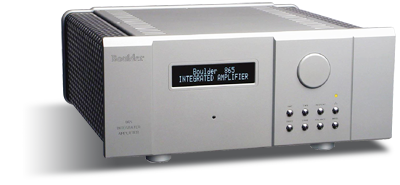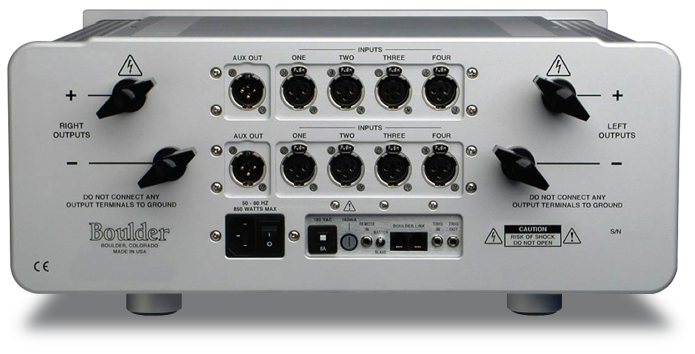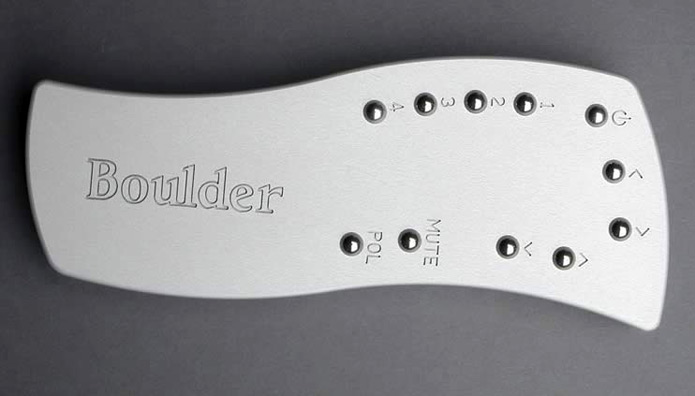
 Since February 2010, I’ve wanted an integrated amplifier to simplify my audio system, functionally and visually. At the beginning of that journey, my system was in a living room, and the combination of preamp and power amp and cables didn’t look so great. No matter how carefully I arranged everything, it always looked a mess. My better half has always been supportive and patient regarding my audio system, but if the clutter of equipment bothered me when friends visited, I’m sure it bothered her. While I’m proud of the quality and, more important, the sound of my system, it had become obvious that something had to change. However, I had one stipulation: I was unwilling to compromise on sound quality. So began my long ride on the merry-go-round of integrated amplifiers.
Since February 2010, I’ve wanted an integrated amplifier to simplify my audio system, functionally and visually. At the beginning of that journey, my system was in a living room, and the combination of preamp and power amp and cables didn’t look so great. No matter how carefully I arranged everything, it always looked a mess. My better half has always been supportive and patient regarding my audio system, but if the clutter of equipment bothered me when friends visited, I’m sure it bothered her. While I’m proud of the quality and, more important, the sound of my system, it had become obvious that something had to change. However, I had one stipulation: I was unwilling to compromise on sound quality. So began my long ride on the merry-go-round of integrated amplifiers.
Enter Boulder
I’ve long been a fan of Boulder Amplifiers -- my introductions to truly high-end audio electronics were their 1010 preamp and 1060 power amplifier, which impressed me with their build quality, inside and out. At the time, though, I wasn’t yet experienced enough with high-end gear to fully appreciate the quality of those components. As I’ve come to learn, full appreciation comes with lots of experience.
The 865 costs $12,500 USD and is part of Boulder’s "entry-level" 800 series, which also includes the 810 preamplifier ($7500), the 850 monoblock power amplifier ($11,500/pair), and the 860 stereo power amp ($9000). The 865 can be thought of as a combination of the 810 and 860: It has the same number of inputs as the 810 (with one less balanced out), and both the 865 and the 860 stereo amp provide 150Wpc into 8 or 4 ohms, with a peak output rating of 300Wpc into 4 ohms. All 800-series components -- in fact, everything Boulder makes -- have the same bead-blasted, milled-aluminum finish.
The 865’s front panel is clean and well organized, with eight buttons and one large knob all in a group to the right of center. Four buttons are for selecting inputs -- the user can switch directly to an input rather than scroll through a list. Of the five integrateds I used over the last year, only two have provided direct-input switching capabilities, which I find preferable; for me, scrolling through inputs is irritating, especially when the input locator on the front panel isn’t easily visible.
The other four buttons are Mute, Display, Balance, and Power. The Display button can be used to adjust the brightness of the readout, which is a pane at the left center of the front panel. The text glows blue at four different levels of brightness: 100%, 75%, 50%, and 25%. When the remote is used with the display set to a brightness of less than 100%, for a few seconds the display briefly returns to full brightness to ensure that the operator is aware that a change has been made, then returns to the brightness already selected. The Balance button is for adjusting the level of the left and right channels. Press it, and the display reads "Balance centered" when the balance is set to "0." After the Balance button has been pressed, the Volume knob can be used to tweak the relative level of the left or right channel. The Balance is accomplished in increments of 1dB. The Standby and Mute buttons perform the obvious duties.
A protective metal mesh covers the heatsinks on both sides of the 865. The mesh is thin, so care should be taken not to move the unit by grasping these covers. On the rear panel are four balanced inputs. Each of these can be switched to a Theater Mode that bypasses the 865’s volume control -- a must-have for audiophiles who also use their audio systems as home-theater rigs. My receiver lacks balanced preamp outputs, but Boulder inquired about my setup before shipping the 865, and sent along a pair of RCA-to-XLR adapters that I used to connect my surround receiver to the 865.
Boulder also provides a balanced set of outputs that can be used to send a signal to a powered subwoofer or a separate power amplifier. The binding posts are big, plastic-shrouded knobs that accept only spades. While my Analysis Plus speaker cables have spades at the amplifier end, their own bulk created a bit of a space problem in connecting them to the 865. The remedy was to turn the 865’s binding-post knob to a point where the spade would barely slide in -- so that the wing of the knob wouldn’t be obstructed by the spade, thus preventing a full revolution -- and then insert the spade. Once a spade was in the slot, the knob provided great leverage for tightening the connection.
Along the bottom of the rear panel are the IEC power inlet, the main power switch, and, to the right of these, the voltage setting. Farther to the right is a Remote In connector, and a Master/Slave switch to be used with BoulderLink, a system that can be used to interconnect all of your Boulder components. When a system is hooked up this way, powering on the Master unit will start the other Boulder units in the proper sequence. However, I had no other Boulder component on hand with which to test this feature.

The 865 is operated with the same remote control used with the 1010 preamp. The remote is contoured to nicely fit the user’s hand, and each of the 865’s four inputs can be accessed directly from it. The Balance button is replaced with a left and a right arrow. The volume is adjusted with up and down arrows, while the Mute and Standby buttons are the same as on the front panel. The remote was easy to use, and the 865’s display was easy to read from about 12’ away.
While sound quality is Boulder’s goal, I found the 865’s controls and user interface to be as good as I have ever experienced -- in fact, intuitive. I’ve also come to appreciate the level of fit’n’finish Boulder puts into their products. The 865 may be an entry-level component for them, but its look and feel are similar to those of their most expensive models.

Sound
And when it came to sound quality, the 865 met that goal as well. I was immediately impressed with the naturalness and ease of reproduction I heard with my favorite music, and the vocal image of Radiohead’s Thom Yorke displayed this incredibly well. With other integrated amps I’ve had in my system, I’ve felt that a slight glare or an unnatural edge surrounded the image of Yorke’s voice, but this completely disappeared with the 865. In "Faust Arp," from In Rainbows (CD, XL 324), Yorke’s voice is big and clean. Accompanied by pairs of acoustic guitars and violins, the words emerge from his mouth like a whisper. I believe the guitars were recorded in an open field, which explains the intro of the song. Combined, these sounds overlap to provide an interesting backdrop for Yorke’s voice. Through the 865, the details of the track’s mix became crystal clear. The voice was free-flowing and lucid, with incredible instrumental separation and a palpable sense of air around each performer. Yorke’s voice sounded somewhat softer than I’m used to, but ultimately I felt that the Boulder 865’s reproduction of it was more natural and accurate. It was definitely easier to listen to.
The Boulder 865 provided a very still, quiet background from which all types of music could emerge. With tracks such as "At Least That’s What You Said," from Wilco’s A Ghost Is Born (CD, Nonesuch 79809), which includes soft and delicately rendered music, a quiet backdrop can help the listener retrieve important ambient details to better feel the mood of the song. Luckily, Wilco doesn’t overcompress this recording’s full dynamic range, meaning the song wasn’t mixed with all elements too loud to sound better on an iPod, as most rock and pop tracks are these days. The instruments seemed to be played by delicately moving fingers as Jeff Tweedy’s voice carefully recalls a lover’s quarrel.
"At Least That’s What You Said" is one of those songs that doesn’t work in a car. To get satisfaction at the beginning of the track, you’d have to turn up the car’s system’s volume a fair bit. Then, at just under two minutes in, the intensity of the song ramps up and Tweedy’s voice starts to rise in volume, until the lead guitar comes in. At this point in a car, I usually find the volume of this track to be a bit loud. But a great audio system can retrieve all the information in this track and deliver the performance the way it was intended to sound. The Boulder 865 was not only able to reproduce this track’s subtlety of sound, it was also able to communicate the song’s sultry mood. An audio system has achieved something great when you feel emotionally involved with the music; with the 865 in my system as I played this track and others like it, I certainly did.
Boulder’s house sound could be described as clean, neutral, natural, and transparent. Based on my listening to several Boulder setups over the years, I believe these adjectives can be applied, to varying degrees, to all of their models, from top to bottom of their product range. And I found that the 865 bettered every other integrated I’ve had in my system in just these ways.
The closest competitor in sound and price to the 865 that I’ve recently had in my system was the Simaudio Moon Evolution 600i ($8000); with all the music I fed it, it cast a spacious soundstage that was detailed and precise. I felt the 865 was just as detailed but even more precise -- it captured low-level resolution in ways unmatched by the Simaudio. In music such as the Finale of William Walton’s Crown Imperial, as performed by Jerry Junkin and the Dallas Wind Symphony with organist Mary Preston, from HR-X Sampler 2011 (24/176.4 WAV, Reference HR-112), both integrateds cast impressively wide and deep soundstages, but the 865 provided a clearer, more vividly detailed view of the players, with more air around instrumental images. About 20 seconds in, what sounds like a xylophone is played. Through the 865, each note rang more clearly, with more shape and definition, than through the Simaudio. I also found the 865 to be more controlled in the lower treble and upper midrange than the Moon Evolution 600i; the latter’s greater sibilance in these regions was clearly revealed by recordings of women’s voices.
Finally, I felt the Boulder 865 played with as hefty a dose of power as any other combination of electronics I’ve had in my home. The best stereo power amplifier I’d had in my room before the 865’s arrival was the Esoteric A-30 ($14,000), a moderately powered class-A design. The A-30 added a touch of warmth to the music I love, but the Boulder 865 added nothing -- yet also held nothing back. It was simply dead neutral. My Rockport Technologies Miras are darn near close to being full-range loudspeakers, and they never lacked for bass push when driven by the 865.
Leading edges were sharp through the 865, pitch and timbre were spot-on accurate, and dynamic expression was fulfilled to the highest degree, characteristics best displayed by percussion and strings. The quick pop of fingers on a set of bongos’ taut drumheads made for incredibly transparent aural images; and the slow bow stroke and low-end extension of the cello, together with the texture of the strings being played, brought that instrument into my room. I never felt there was a time when I pushed the 865 too hard, and in terms of power delivery it never showed any sign of crying uncle. The Boulder 865 plowed through lots of bass-heavy music and remained cool -- literally -- at all times. Never once did I place a hand on the case and feel much heat. The 865 may be the coolest-running amplifier I’ve ever used.
Conclusions
My ride on the merry-go-round of integrated amplifiers ended when I caught the brass ring: the Boulder 865. I loved the 865 -- it delivered everything I’ve come to expect from Boulder: great sound, excellent build, nice user interface. The 865’s fit’n’finish is as good as you’ll see in any audio component. The layout of the rear panel is clean, well thought out, and easy to navigate. And the 865’s user interface provides a quality of experience that adds only enjoyment to its use. In short, the 865 is physically everything you should expect for a product costing $12,500.
But while those qualities are nice, they’re but the cherry on top. The real meal was the sound. The Boulder 865 is the most detailed and transparent integrated amplifier I’ve heard over the past year: Its highs and lows were impressively extended and detailed, and its midrange was very smooth and natural. If I were banished to a desert island and could bring only one integrated amplifier with me, the Boulder 865 would be it. It’s the best option I know of for someone who doesn’t want separates but still wants reference-grade sound.
. . . Randall Smith
randalls@soundstagenetwork.com
Associated Equipment
- Speakers -- Rockport Technologies Mira
- Integrated amplifier -- Simaudio Moon Evolution 600i
- Sources -- Apple iMac, Weiss DAC2, Amarra 2.1, iTunes music player
- Speaker cables -- Analysis Plus Silver Oval
- Interconnects -- Analysis Plus Silver Oval-In
- Power conditioner -- Blue Circle Audio BC6000
Boulder Amplifiers 865 Integrated Amplifier
Price: $12,500 USD.
Warranty: Five years parts and labor.
Boulder Amplifiers, Inc.
3235 Prairie Avenue
Boulder, CO 80301
Phone: (303) 449-8220
E-mail: sales@boulderamp.com
Website: www.boulderamp.com






















